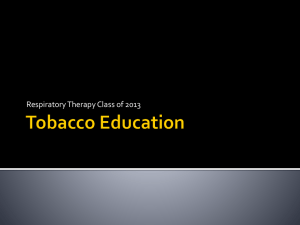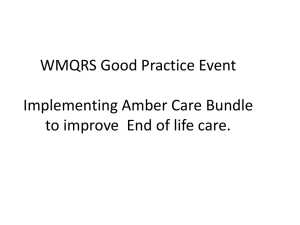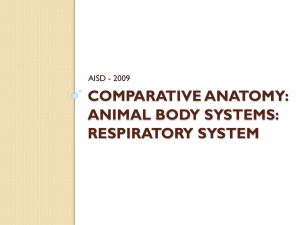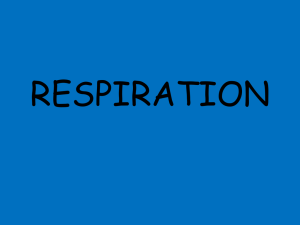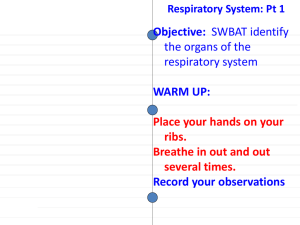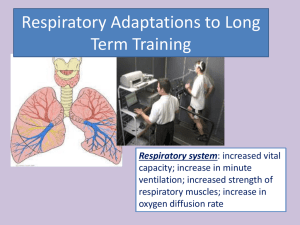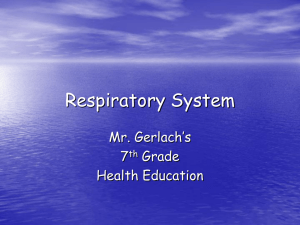Respiratory System
advertisement
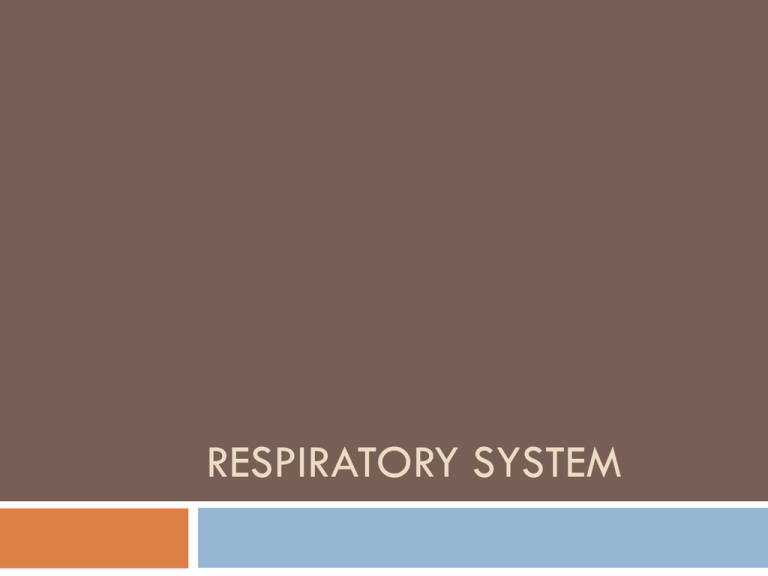
RESPIRATORY SYSTEM Introduction So far we have studied respiration on a cellular level What do we remember? Purpose? Reactants? Products? What is respiration on an internal and external level? external respiration = process of exchanging respiratory gases with the external environment. Internal respiration = the exchange of oxygen and carbon dioxide between blood and the cells of the surrounding tissue Respiratory System What structures make up the human respiratory system? Trace a molecule of O2 from the outside air through your body, and back out again as CO2 Respiratory System most organisms on earth are aerobic require oxygen to survive. For both unicellular organisms, like the amoeba, or multicellular organisms (us), every cell in the body needs O2 Why do all of our cells need O2? Cellular respiration: the process that releases the energy needed to drive all cell functions Respiratory System We also need respiration to remove CO2. Therefore, the basic function of the respiratory system is gas exchange = to make sure that O2 can enter each cell in the organism, and that CO2 can leave each cell. Gas Exchange Different organisms have different kinds of respiratory systems to accomplish the task of gas exchange. Every respiratory system shares two requirements: 1. 2. Respiratory surface area must be high enough for gas exchange to occur at a rate that will meet the organism’s energy needs Second, respiration must take place in a moist environment, so that the oxygen and carbon dioxide are dissolved. Gas Exchange Simple Respiratory Systems: Most single-celled aerobic organisms do NOT have a distinct respiratory system. Algae, fungi, and some bacteria, etc Rely on simple diffusion to meet their gas exchange requirements. These organisms need moist environments, aquatic environments Other moist places such as within the body of a host organism Gas Exchange O2 that is dissolved in the water around the cell diffuses through the outer cell membrane at the same time, carbon dioxide diffuses out. The cell membrane itself provides a moist surface area big enough to accommodate gas exchange. Diffusion Volvox: These simple organisms can also depend on diffusion alone to meet their gas exchange requirements. Gas Exchange The Specialized Respiratory System: The larger and more complex an organism is the more oxygen it requires to supply its cells the greater the distance over which that oxygen must travel in order to reach all of the cells The more specialized it’s body become, reducing the surface for gas exchange Therefore, these complex organisms can not rely on diffusion alone to provide O2 to the cells of the body Gas Exchange Adaptations within complex animals have produced several different respiratory systems. All of the higher animals have evolved a specialized respiratory system that includes: A respiratory surface Passageways to connect this surface to the external environment Muscular structures that help bring air into contact with the respiratory surface Respiratory Systems Skin Respiration e.g. Worms can survive only in water or in damp earth Gas is exchanged through the moist skin into tiny capillaries Respiratory Systems Gills e.g. fish a mechanism has evolved that enables the animal to move the oxygen-containing water over the respiratory surface (Ventilation) This allows the respiratory surface to be constantly exposed to a fresh supply of oxygen, which makes up for the reduced surface area Gills are feathery tissue structures with numerous delicate branches Respiratory Systems As creatures begin to colonize land environments, adaptations were needed to provide a constantly moist surface Therefore, all terrestrial animals have evolved some way to carry a moist respiratory environment wherever they go. Terrestrial animals also utilize ventilation. = passing an oxygen-rich medium over the respiratory surface Breathing Breathing = the act of ventilating a respiratory surface with air Breathing relies on a basic law of physics: air will move from a region of higher pressure to a region of lower pressure until equilibrium is reached. Different terrestrial animals have evolved different ways to make use of this principle in their respiratory systems. Breathing LUNG EXTERNAL ENVIRONMENT Breathing LUNG EXTERNAL ENVIRONMENT Breathing LUNG EXTERNAL ENVIRONMENT Respiratory Systems Tracheal Respiration Insects use spiracles to solve the dilemma of maintaining a moist respiratory surface controlled by valves lead to an internal network of tubes called tracheae the abdomen of a grasshopper actually contracts and relaxes rhythmically. = breathing the animal’s breathing causes an orderly movement of air through the tracheae Respiratory Systems In insects, the respiratory and circulatory systems are separate from one another The circulatory system is not needed to transport O2 Instead, there are many branches of the tracheal tubes ensures that the respiratory surface is in close enough contact with all of the living cells allow gas exchange to occur by diffusion across the moist tracheal walls Respiratory Systems The Lung an internal respiratory surface connected to the external environment by means of internal passageways Although they vary from species to species, all lung systems consist of three basic elements: 1. 2. 3. One or two lungs that have a moist respiratory surface Forcibly bring air into contact with the lung surface A circulatory system to carry gases between the lungs and the other cells of the body. Lungless Lunged Gills Class Activity Design a living creature that makes use of several different respiratory systems. Skin Respiration Gills Tracheal Tubes Lungs Make sure you address the two main requirements for all respiratory systems
